AMD’s 2016-2017 x86 Roadmap: Zen Is In, Skybridge Is Out
by Ryan Smith on May 6, 2015 2:02 PM EST- Posted in
- CPUs
- AMD
- AMD FAD 2015
- Zen
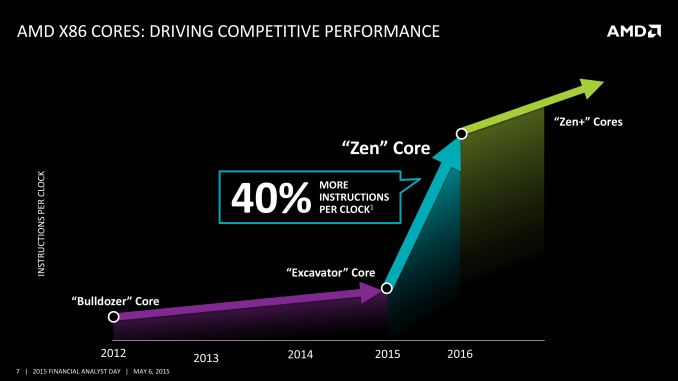
AMD’s CTO Mark Papermaster just left the stage at AMD’s 2015 Financial Analyst Day, and one of the first things he covered was AMD’s CPU technology roadmap for the next couple of years.
The big question on everyone’s mind over the last year has been AMD’s forthcoming x86 Zen CPU, developed by Jim Keller’s group, and Papermaster did not disappoint, opting to address the future of AMD’s x86 plans first and foremost. AMD is not releasing the complete details on Zen until closer to its launch in 2016, but today they are providing some basic details on the CPU’s abilities and their schedule for it.
In terms of features, AMD once again confirmed that they’re aiming for significantly higher performance, on the order of a 40% increase in Instruction Per Clock (IPC) throughput. In a significant shift in threading for AMD’s x86 CPUs, Zen will also shift from Bulldozer’s Clustered Multithreading (CMT) to Simultanious Multithreading (SMT, aka Intel’s Hyperthreading). CMT is the basis for Bulldozer’s unusual combination of multiple integer cores sharing a single FPU within a module, so the move to SMT is a more “traditional” design for improving resource usage, and it means Zen will similarly have a more traditional resource layout. AMD is also labeling Zen’s cache as a “high-bandwidth, low latency cache system,” though at this time they aren’t quantifying just how that differs from the Dozer family’s cache.
Meanwhile AMD has confirmed that Zen will be shipping in 2016, and that it will be produced on a yet-to-be-named FinFET process. Our bet would be that AMD continues to use traditional partner (and spin-off fab) GlobalFoundries, who will be ramping up their 14nm equipment for next year as part of their licensing/partnership with Samsung to implement Samsung’s 14nm FinFET process. Zen at this time is AMD’s priority, to the point where the company is willing to push back the ARM K12 in order to get Zen out the door first.
Desktop users will be happy to know that the first Zen processor out the door will be AMD’s high-end desktop CPU (AMD was very deliberate in this, it’s not an APU). AMD will be aiming high and then cascading Zen down into APUs and lower-end products.
Said Zen CPU will use a new AMD platform – AM4 – which will also support DDR4. Unlike the Dozer family, all of AMD’s desktop CPUs will use the same AM4 platform/socket, so when AMD does ramp up their Zen APU, it too will be on AM4 and not its own socket, simplifying the process.
Finally, AMD’s roadmap for Zen over 2016-2017 calls for further improved Zen cores, “Zen+”, later on. Though the biggest jump for AMD comes from the transition from Dozer to Zen, the company is looking to push the envelope on IPC harder than they did with the Dozer family, projecting a higher increase in IPC over time than what we saw with the Dozer parts.
As for what this means for single-threaded performance, that remains to be seen. After having chased a lower-IPC/higher-clockspeed strategy in an attempt to do something different from Intel – the AMD that designed Bulldozer thought it wise not to try to beat well-funded Intel at their own game – the focus on higher IPC is arguably the correct move to make as the laws of physics have continued to keep 5GHz+ clockspeeds from being efficient enough to be practical. That said, single-threaded performance is a combination of IPC and clockspeed, so to be competitive with Intel AMD needs to deliver higher IPC while maintaining relatively high clockspeeds, and the latter is not something AMD is disclosing this early in the process.
Finally, we’ll note that this roadmap is empty of any mentions of project Skybridge. CEO Lisa Su has commented that AMD has decided to change their focus away from Skybridge based on customer feedback. Customers were telling AMD that they didn't necessarily need socket compatible solutions, so AMD is going to work on differentiated solutions. That said, given that Skybridge was announced last year and planned for 20nm, I suspect that it has also become a victim of the short lifespan (and underperforming nature) of 20nm, leading to it being downplayed in favor of 14nm prodcts.
Meanwhile also absent was any further mention of AMD's Cat cores. Zen would appear to be AMD’s top-to-bottom x86 core, a significant departure from an AMD who previously wanted separate designs for the 10W-100W market and sub-10W markets.


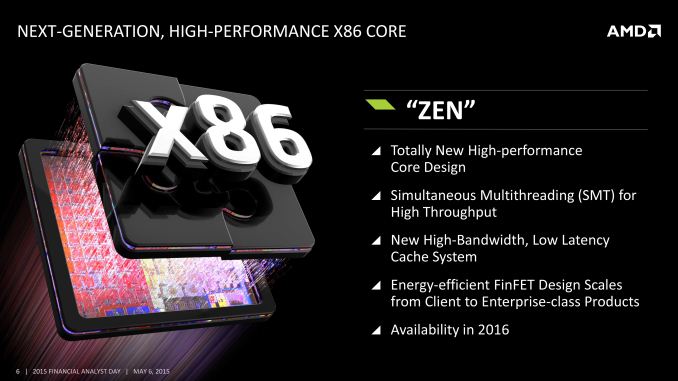
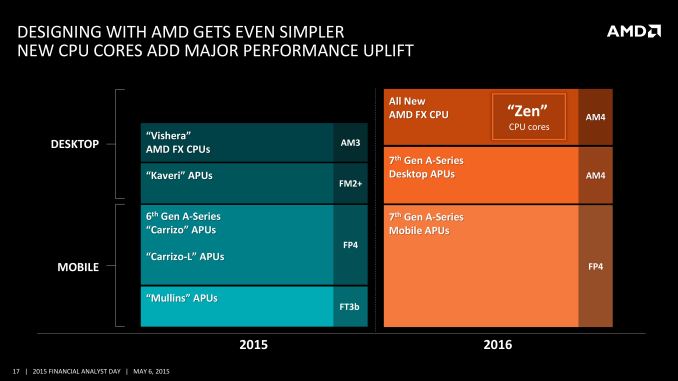
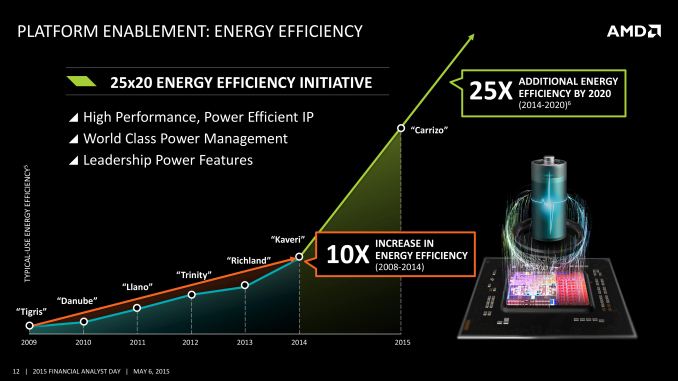
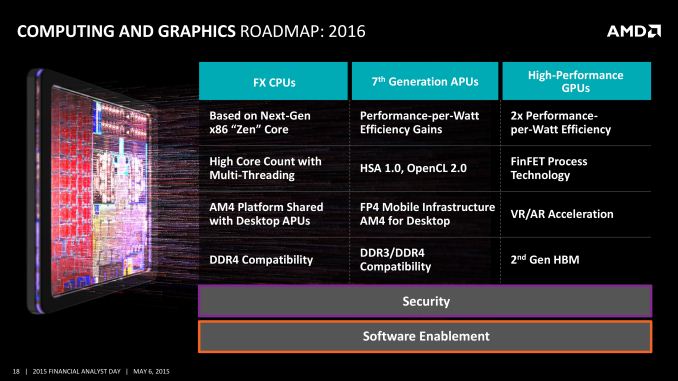








59 Comments
View All Comments
Flunk - Wednesday, May 6, 2015 - link
Looking forward to it, I'm getting sick of constantly explaining to people why buying AMD processors doesn't make any sense right now (unless you're using the integrated GPU).testbug00 - Wednesday, May 6, 2015 - link
If you to render really cheaply, the throughput is oustanding for the price.And, if you need absolute budget gaming, going FX-4xxx or Athlon might be better than Pentium. Depending on the games being played. Overall still favors pentium heavily.
Yes, very hard to recommend them overall.
dragonsqrrl - Wednesday, May 6, 2015 - link
"If you to render really cheaply, the throughput is oustanding for the price."No it really isn't anymore. That hasn't been true since the Piledriver based Opteron 6300's first launched, back when they were competing against Sandy Bridge based Xeon E5's. Intel has gone through 2 Xeon generations since, while AMD is still relying on practically the same lineup.
My roommate and I were thinking about putting together a relatively low budget dedicated render box, and after doing some research I came to realize that AMD is no longer performance competitive at practically every price point they're currently competing at. Targeting the 300-$400 price range per processor (for a dual processor build), the two SKU's that currently compete with each other are the Opteron 6344 (12 "core" @ 2.6 GHz) and the Xeon E5 2620 V3 (6-core @ 2.4 GHz). Before even looking at a benchmark I think anyone who's familiar with the current performance landscape between AMD and Intel could figure out fairly quickly that there's no way Piledriver can compete at equivalent module to core counts and similar clock speeds as Haswell. Haswell will outperform it in highly-threaded workloads, and absolutely demolish it in single/lightly threaded workloads. But by how much exactly? After digging a little deeper it turns out that on average the Xeon E5 2620 V3 is ~30% faster than the Opteron 6344 in highly threaded workloads. I checked a few other price points going all the way up to ~$700, and the general story is the same. Intel simply has faster server processors with lower TDP's at competing price points right now.
testbug00 - Wednesday, May 6, 2015 - link
6-8 INT cores for rendering from AMD is ~95-~135 dollars for entry. I'm talking super cheapo rendering.dragonsqrrl - Wednesday, May 6, 2015 - link
I would say that's practically irrelevant if you're trying to do any sort of even remotely serious desktop rendering, particularly animation. The time it would take to iterate would simply be too great.MrSpadge - Wednesday, May 6, 2015 - link
The current Opterons are so old. I don't understand why they don't even try to sell a few more of them, as apparently they're still making them. Give customers a few more cores and someone will bite. If Zen is so much better they won't even hurt their own future sales. But instead it looks like they're not even trying any more (with the current chips).KAlmquist - Wednesday, May 6, 2015 - link
AMD is concentrating its engineering resources on Zen. Adding more Piledriver based chips to their lineup would not generate significant sales, and would take resources away from Zen.KennyDude27 - Thursday, May 7, 2015 - link
It really depends on what application as well. Video rendering is still much cheaper on amd if you consider total costs in terms of value. Yes intel will beat it amd. But its more of in terms your paying $250 to get a $700 90% of intels performance. I mean you want to pay that extra $450 to say your king on top you can but for me, I'd day $250 per cpu to get 90% of the performance. Ofcourse not counting electricity costs and such but the trend for tdp is generally going low thats not a really concern for personalized video rendering. If your a big farm house thats a totally different story.dysonlu - Thursday, May 7, 2015 - link
Can you explain? They are so cheap compared to Intel. The performance/price should be competitive.garbagedisposal - Wednesday, May 6, 2015 - link
fancy schmancy powerpoints ya